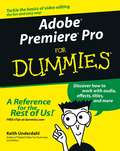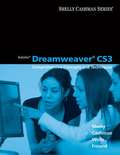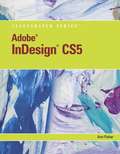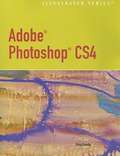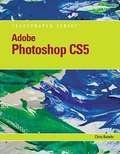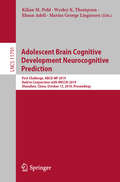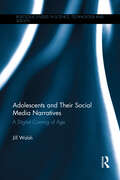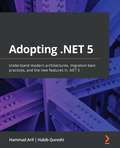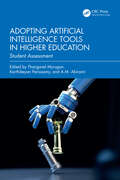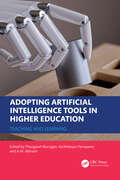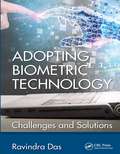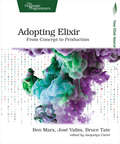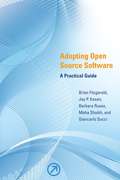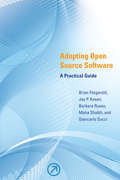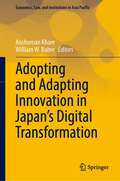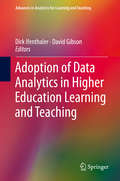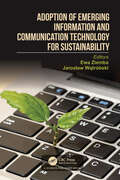- Table View
- List View
Adobe Premiere Pro For Dummies
by Keith UnderdahlAn essential resource for anyone who wants to get up and running with this popular video-editing application, from amateur and hobbyist filmmakers to professionals who want to explore the possibilities of editing on a PCExplains how to shoot good footage, get digital video onto a PC, set up a Premiere production studio, edit clips, add effects, work with audio, and output the finished product or share it onlineReleased day and date with the new software version, the book covers the latest Premiere features and improvementsKeith Underdahl, the author of Digital Video For Dummies (0-7645-4114-5) and other books on digital video, has broad experience as both an amateur videographer and professional video producer
Adobe® Dreamweaver® CS3-Revealed
by Sherry BishopWhether you're looking for a step-by-step guide to introduce you to Adobe Dreamweaver CS3 or a solid reference to assist you as you continue your work in web design, this is the resource you've been looking for! Adobe Dreamweaver CS3 Revealed uses detailed, vibrant illustrations, clear, straightforward lessons, and real-world case studies to provide an overview of the Dreamweaver interface and how to use it effectively. This latest edition includes expanded content on using CSS, inserting video files, using Adobe Bridge CS3, conducting browser compatibility checks and more, reflecting the most recent updates to the Dreamweaver software, as well as those that have occurred in the larger environment of web design. Sidebars throughout the book incorporate basic web design principles, providing readers with a skill set that goes beyond the software interface and can be applied in a variety of situations.
Adobe® Dreamweaver® CS3: Comprehensive Concepts and Techniques
by Gary B. Shelly Thomas J. Cashman Dolores J. Wells Steven M. FreundNIMAC-sourced textbook
Adobe® Dreamweaver® CS4: Illustrated
by Sherry BishopDesigned to meet the needs of users from a broad range of experience levels, ADOBE Dreamweaver CS4 - ILLUSTRATED equips your students with Dreamweaver basics?and well beyond?using the insightful, user-friendly format for which the Illustrated Series is known. Covering the nuts and bolts, new cutting-edge features, and everything in between, the text presents each skill on a succinct, easy-to-understand, two-page spread?making for focused and thorough instruction. Detailed coverage and innovative learning tools maximize user success! From novice to experienced, ADOBE Dreamweaver CS4 - ILLUSTRATED offers invaluable knowledge and insight to take users' skills to the next level.
Adobe® Dreamweaver® CS6, Comprehensive
by Corinne L. Hoisington Jessica L. MinnickADOBE DREAMWEAVER CS6: COMPREHENSIVE, 1E follows the Shelly Cashman Series proven step-by-step, screen-by-screen approach to teaching the Adobe Dreamweaver CS6 software.
Adobe® Dreamweaver® Creative Cloud™, Comprehensive (Stay Current With Adobe Creative Cloud Ser.)
by Corinne L. Hoisington Jessica L. MinnickNIMAC-sourced textbook
Adobe® InDesign® CS3: Revealed
by Chris BotelloGraphic design professionals and design students alike are discovering the smart, sophisticated approach of the page layout software, Adobe InDesign. And they're mastering it with Adobe InDesign CS3 Revealed, a thorough overview of the latest release of the software. This highly visual book begins by covering the workspace and other fundamental concepts. Each subsequent chapter delves into new features, offering more in-depth coverage as the book progresses. With new material on the improved interface and features of CS3, this edition retains its step-by-step tutorials and user-friendly design, resulting in a resource that is comprehensive, clear, and effective.
Adobe® Photoshop® CS3: Comprehensive Concepts and Techniques
by Gary B. Shelly Thomas J. Cashman Joy L. StarksNIMAC-sourced textbook
Adobe® Photoshop® CS4: Illustrated
by Chris BotelloThis edition does not include Review Pack: Adobe Photoshop CS4, Illustrated but it can be purchased separately, using ISBN 1111530947.
Adobe® Photoshop® CS5: Illustrated
by Chris BotelloLearning has never been easier than with ADOBE PHOTOSHOP CS5 ILLUSTRATED. This reader-friendly book presents each skill on two facing pages, providing detailed instructions on the left-hand page and large, full-color screenshots on the right page. The visual format helps you intuitively grasp the concepts in the book and apply them to the classroom and workplace environment.
Adobe® Photoshop® Creative Cloud, Comprehensive
by Joy StarksADOBE PHOTOSHOP CREATIVE CLOUDTM: COMPREHENSIVE, 1st Edition has been fully revised to meet Adobe’s most recent Creative Cloud updates. Coverage of the newest Photoshop functions and tools bring relevancy to your course while helping you maximize your potential with the Photoshop software and familiarize themselves with the Creative Cloud. Part of the highly successful Shelly Cashman Series, ADOBE PHOTOSHOP CREATIVE CLOUD: COMPREHENSIVE, 1ST Edition follows the proven Shelly Cashman Series step-by-step, screen-by-screen approach to learning the Photoshop software. In this text, you will find features designed to engage, improve retention, and prepare you for future success. Expand your understanding of the Photoshop software and graphic design concepts through experimentation, exploration and planning ahead. End of chapter exercises prepare you to become a more capable software user by requiring you to use critical-thinking and problem-solving skills.
Adolescent Brain Cognitive Development Neurocognitive Prediction: First Challenge, ABCD-NP 2019, Held in Conjunction with MICCAI 2019, Shenzhen, China, October 13, 2019, Proceedings (Lecture Notes in Computer Science #11791)
by Marius George Linguraru Ehsan Adeli Kilian M. Pohl Wesley K. ThompsonThis book constitutes the refereed proceedings of the First Challenge in Adolescent Brain Cognitive Development Neurocognitive Prediction, ABCD-NP 2019, held in conjunction with MICCAI 2019, in Shenzhen, China, in October 2019. 29 submissions were carefully reviewed and 24 of them were accepted. Some of the 24 submissions were merged and resulted in the 21 papers that are presented in this book. The papers explore methods for predicting fluid intelligence from T1-weighed MRI of 8669 children (age 9-10 years) recruited by the Adolescent Brain Cognitive Development Study (ABCD) study; the largest long-term study of brain development and child health in the United States to date.
Adolescents and Their Social Media Narratives: A Digital Coming of Age (Routledge Studies in Science, Technology and Society)
by Jill WalshAdolescents are forging a new path to self-development, taking advantage of the technology at their fingertips to produce desired results. In Adolescents and Their Social Media Narratives, Walsh specifically explores how social media impacts teenagers' personal development. Indeed, through unique empirical data, Walsh presents an aspect of teen media use that is not often documented in the press—the seemingly deep and meaningful process of evaluating the self visually in an attempt to reconcile their presentation with their internal "self-story." Nevertheless, as Walsh outlines, this is not a process without its challenges. Tracking teenagers’ progress towards self-validation from the offline stages preceding online exhibitions, this enlightening volume will appeal to undergraduate and postgraduate students, scholars, and researchers interested in fields such as Social Media Studies, Sociology of Adolescence, Identity Formation, Developmental Psychology, and Society and Technology.
Adopt Me!: An Original Novel (Adopt Me!)
by Kiel PhegleyBased on the fan-favorite game Adopt Me! comes this action-packed original middle grade novel featuring charming illustrations throughout. Now available in a lower-priced hardcover edition!Sophia Lee and her best friend, Kat, live on Adoption Island, a paradise filled with pets, customizable homes, and endless adventures. But their world is turned upside down when they discover that the entire island's beloved pets are starting to go missing.As panic spreads across the island, Sophia, Kat, Pinky, Jumper, Finn, and a legendary Queen Bee named Matilda must embark on a quest to uncover the truth. Their journey leads them to encounter everything from a self-proclaimed king to a talking book with cryptic clues and the island's most popular party host.When the friends stumble upon a hidden camp where the missing pets are held captive, the story takes a shocking twist that will ultimately test Sophia and Kat's friendship. Sophia must stand up for what's right, even if it means risking everything. Will Sophia and Kat save the pets and restore peace to Adoption Island?Perfect for fans of action-packed adventures and the fan-favorite online game, this book includes illustrations throughout!
Adopting .NET 5: Understand modern architectures, migration best practices, and the new features in .NET 5
by Hammad Arif Habib QureshiA practical guide to building and upgrading new and legacy applications on cloud-native platforms using architectural best practices with .NET 5, C# 9, microservices, and ML.NETKey FeaturesGet up to speed with .NET 5's new improvements and featuresDiscover how to improve existing code design and enhance software maintainabilityExplore explanations and techniques for making programs easier to understand and changeBook Description.NET 5 is the unification of all .NET technologies in a single framework that can run on all platforms and provide a consistent experience to developers, regardless of the device, operating system (OS), or cloud platform they choose. By updating to .NET 5, you can build software that can quickly adapt to the rapidly changing demands of modern consumers and stay up to date on the latest technology trends in .NET. This book provides a comprehensive overview of all the technologies that will form the future landscape of .NET using practical examples based on real-world scenarios, along with best practices to help you migrate from legacy platforms. You'll start by learning about Microsoft's vision and rationale for the unification of the platforms. Then, you'll cover all the new language enhancements in C# 9. As you advance, you'll find out how you can align yourself with modern technology trends, focusing on everything from microservices to orchestrated containerized deployments. Finally, you'll learn how to effectively integrate machine learning in .NET code. By the end of this .NET book, you'll have gained a thorough understanding of the .NET 5 platform, together with a readiness to adapt to future .NET release cycles, and you'll be able to make architectural decisions about porting legacy systems and code bases to a newer platform.What you will learnExplore the key performance improvement areas when migrating to modern architecturesUnderstand app design and development using .NET 5Discover how to shift from legacy to modern application design using microservices and cloud-native architectureExplore common migration pitfalls and make the right decisions in situations where multiple options are availableUnderstand the process of deploying .NET 5 code on serverless and containerized hosts, along with its benefitsFind out what ML.NET has to offer and build .NET apps that use machine learning servicesWho this book is forThis book is for experienced developers as well as software architects who are looking to gain knowledge of the new features and capabilities of .NET 5, along with guidance on modern architectural patterns. If you're a developer who has previously worked on .NET, WPF, ASP.NET, Entity Framework, or other popular .NET libraries, this book will help you understand the migration process for their modern counterparts. Although experience with .NET Core is not required, working knowledge of the C# language and .NET framework is assumed.
Adopting Artificial Intelligence Tools in Higher Education: Student Assessment
by Thangavel Murugan Karthikeyan Periasamy A. M. AbiramiThis edited volume explores the adoption of artificial intelligence (AI) tools in higher education, specifically focusing on student assessment. It examines the integration of various AI tools within higher education, discussing the challenges and opportunities they present and the innovative solutions they offer.The chapters explore various issues surrounding the use of AI in higher education and propose potential solutions. The book begins with a systematic exploration of AI's potential, presenting innovative ways to ensure fair and accurate assessments that enhance the overall quality of education. It highlights the benefits of AI-powered grading systems that streamline assessment processes, provide timely feedback, and promote fair evaluations. The text discusses how machine learning algorithms can revolutionize assessment methods, allowing individualized, adaptive testing tailored to each student's unique needs. Furthermore, it examines natural language processing (NLP) techniques for evaluating student essays by analyzing linguistic features such as grammar and semantic coherence. Moreover, it highlights AI-powered virtual assistants offering personalized feedback and learning recommendations. Case studies illustrate successful AI assessment implementations and methods for improving AI-based evaluations. The book also addresses engagement and success in the post-COVID-19 context. It raises concerns about plagiarism and academic integrity, comparing AI solutions to traditional methods while exploring the challenges associated with adopting AI in education. Educators, administrators, academics, and technology experts working in institutes of higher learning will find this volume compelling. It is also suitable for students taking courses in educational technology, e-learning, and digital learning.
Adopting Artificial Intelligence Tools in Higher Education: Teaching and Learning
by Thangavel Murugan Karthikeyan Periasamy A. M. AbiramiThis book offers a modern exploration of the intersection of technology and education. It examines the prospects of integrating different AI tools into higher education and explores the challenges, opportunities, and innovative solutions for the different issues surrounding the use of AI in higher education.Each chapter discusses a different area where AI can enhance the educational landscape, such as AI integration in higher education and immersive virtual reality-based learning environments. The book also emphasizes student-centered learning, AI-powered frameworks for academic excellence, and learner-centric pedagogies. Furthermore, it delves into the role of AI in personalized learning in STEM courses, the development of AI-based tutoring systems, and the use of machine learning to identify students’ mental health status. The volume concludes with "Dynamic Horizon," which examines how AI and gamification are shaping higher education.This book is essential for educators, administrators, researchers, and policymakers who want to leverage AI to create an adaptive, personalized, and engaging learning environment. Adopting Artificial Intelligence Tools in Higher Education provides valuable insights into the future of education, paving the way for a more empowered and enlightened academic world.
Adopting Biometric Technology: Challenges and Solutions
by Ravindra DasMany types of security technologies are currently in use, with biometrics being one of the latest and most cutting-edge forms that has been produced for mass application. Biometrics, while intriguing, is often broached with hesitation and poor understanding. Adopting Biometric Technology: Challenges and Solutions advocates increased implementation of biometric technology areas of the world where it has been least accepted, particularly in the United States. This book looks at several specific applications of biometric technology, challenging issues that have obstructed the use of biometrics in security and offering realistic solutions for increasing its worldwide utilization. It is divided into three sections, with the first discussing societal barriers against the adoption of biometric technology in security. The second section presents case studies of specific applications, such as e-passports and e-voting, that have already been implemented and could be expanded into regions where usage is low. The third section lays out a case for the general practicality and value that biometrics offers to relevant business sectors, including the benefits of implementing the currently controversial technology in place of the conventional forms of verification. While biometric technology has been poorly accepted and adopted in the United States as well as other developed nations, it is already a popular tool in developing nations in Asia, Africa, and Eastern Europe. Adopting Biometric Technology examines the societal resistance hindering the broader usage of biometrics and provides practical solutions for overcoming those barriers while showing how its increased application would be overall advantageous.
Adopting Elixir: From Concept to Production
by Bruce Tate Jose Valim Ben MarxAdoption is more than programming. Elixir is an exciting new language, but to successfully get your application from start to finish, you're going to need to know more than just the language. The case studies and strategies in this book will get you there. Learn the best practices for the whole life of your application, from design and team-building, to managing stakeholders, to deployment and monitoring. Go beyond the syntax and the tools to learn the techniques you need to develop your Elixir application from concept to production. Learn real-life strategies from the people who built Elixir and use it successfully at scale. See how Ben Marx and Bleacher Report maintain one of the highest-traffic Elixir applications by selling the concept to management and delivering on that promise. Find out how Bruce Tate and icanmakeitbetter hire and train Elixir engineers, and the techniques they've employed to design and ensure code consistency since Elixir's early days. Explore customer challenges in deploying and monitoring distributed applications with Elixir creator Jose Valim and Plataformatec. Make a business case and build a team before you finish your first prototype. Once you're in development, form strategies for organizing your code and learning the constraints of the runtime and ecosystem. Convince stakeholders, both business and technical, about the value they can expect. Prepare to make the critical early decisions that will shape your application for years to come. Manage your deployment with all of the knobs and gauges that good DevOps teams demand. Decide between the many options available for deployment, and how to best prepare yourself for the challenges of running a production application. This book picks up where most Elixir books leave off. It won't teach you to program Elixir, or any of its tools. Instead, it guides you through the broader landscape and shows you a holistic approach to adopting the language. What You Need: This book works with any version of Elixir.
Adopting Open Source Software
by Jay P. Kesan Brian Fitzgerald Barbara Russo Maha Shaikh Giancarlo SucciGovernment agencies and public organizations often consider adopting open source software (OSS) for reasons of transparency, cost, citizen access, and greater efficiency in communication and delivering services. Adopting Open Source Software offers five richly detailed real-world case studies of OSS adoption by public organizations. The authors analyze the cases and develop an overarching, conceptual framework to clarify the various enablers and inhibitors of OSS adoption in the public sector. The book provides a useful resource for policymakers, practitioners, and academics. The five cases of OSS adoption include a hospital in Ireland; an IT consortium serving all the municipalities of the province of Bozen-Bolzano, Italy; schools and public offices in the Extremadura region of Spain; the Massachusetts state government's open standards policy in the United States; and the ICT department of the Italian Chamber of Deputies. The book provides a comparative analysis of these cases around the issues of motivation, strategies, technologies, economic and social aspects, and the implications for theory and practice.
Adopting Open Source Software: A Practical Guide
by Jay P. Kesan Brian Fitzgerald Barbara Russo Maha Shaikh Giancarlo SucciA rich case-study analysis of open source software adoption by public organizations in different countries and settings.Government agencies and public organizations often consider adopting open source software (OSS) for reasons of transparency, cost, citizen access, and greater efficiency in communication and delivering services. Adopting Open Source Software offers five richly detailed real-world case studies of OSS adoption by public organizations. The authors analyze the cases and develop an overarching, conceptual framework to clarify the various enablers and inhibitors of OSS adoption in the public sector. The book provides a useful resource for policymakers, practitioners, and academics.The five cases of OSS adoption include a hospital in Ireland; an IT consortium serving all the municipalities of the province of Bozen-Bolzano, Italy; schools and public offices in the Extremadura region of Spain; the Massachusetts state government's open standards policy in the United States; and the ICT department of the Italian Chamber of Deputies. The book provides a comparative analysis of these cases around the issues of motivation, strategies, technologies, economic and social aspects, and the implications for theory and practice.
Adopting and Adapting Innovation in Japan's Digital Transformation (Economics, Law, and Institutions in Asia Pacific)
by Anshuman Khare William W. BaberThis book explores how the business transformation taking place in Japan is influenced by the digital revolution. The chapters present approaches and examples from sectors commonly understood to be visible arenas of digital transformation—3D printing and mobility, for instance—as well as some from not-so-obvious sectors, such as retail, services, and fintech.Business today is facing unprecedented change especially due to the adoption of new, digital technologies, with a noticeable transformation of manufacturing and services. The changes have been brought by advanced robotics, the emergence of artificial intelligence, and digital networks that are growing in size and capability as the number of connected devices explodes. In addition, there are advanced manufacturing and collaborative connected platforms, including machine-to-machine communications. Adoption of digital technology has caused process disruptions in both the manufacturing and services sectors and led to new business models and new products. While examining the preparedness of the Japanese economy to embrace these changes, the book explores the impact of digitally influenced changes on some selected sectors from a Japanese perspective. It paints a big picture in explaining how a previously manufacturing-centric, successful economy adopts change to retain and rebuild success in the global environment. Japan as a whole is embracing, yet also avoiding—innovating but also restricting—various forms of digitalization of life and work. The book, with its 12 chapters, is a collaborative effort of individuals contributing diverse points of view as technologists, academics, and managers.
Adoption of Data Analytics in Higher Education Learning and Teaching (Advances in Analytics for Learning and Teaching)
by David Gibson Dirk IfenthalerThe book aims to advance global knowledge and practice in applying data science to transform higher education learning and teaching to improve personalization, access and effectiveness of education for all. Currently, higher education institutions and involved stakeholders can derive multiple benefits from educational data mining and learning analytics by using different data analytics strategies to produce summative, real-time, and predictive or prescriptive insights and recommendations. Educational data mining refers to the process of extracting useful information out of a large collection of complex educational datasets while learning analytics emphasizes insights and responses to real-time learning processes based on educational information from digital learning environments, administrative systems, and social platforms. This volume provides insight into the emerging paradigms, frameworks, methods and processes of managing change to better facilitate organizational transformation toward implementation of educational data mining and learning analytics. It features current research exploring the (a) theoretical foundation and empirical evidence of the adoption of learning analytics, (b) technological infrastructure and staff capabilities required, as well as (c) case studies that describe current practices and experiences in the use of data analytics in higher education.
Adoption of Emerging Information and Communication Technology for Sustainability
by Ewa Ziemba JarosławThis book represents an important voice in the discourse on the adoption of emerging ICT for sustainability. It focuses on how emerging ICT acts as a crucial enabler of sustainability, offering new forward-looking approaches to this field. The book explores how emerging ICT adoption drives sustainability efforts in business and public organizations, promoting ecological, economic, social, cultural, and political sustainability. The book's theoretical discussions, conceptual approaches, empirical studies, diverse perspectives, and views make it a valuable and comprehensive reference work. Appealing to both researchers and practitioners, this book provides significant areas for research and practice related to the contribution of emerging ICT adoption to sustainability. It also suggests vital considerations for programming and building sustainable development-driven emerging ICT adoption. Readers will find answers to important contemporary questions, such as: What are the concepts, frameworks, models, and approaches to enhance sustainable development through the adoption of emerging ICT? How does the adoption of emerging ICT influence sustainability? How can emerging ICT be adopted to enhance sustainability? What are the current practices and successful cases of emerging ICT adoption for sustainability? What factors influence emerging ICT adoption to enhance sustainability?
